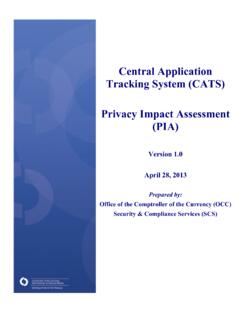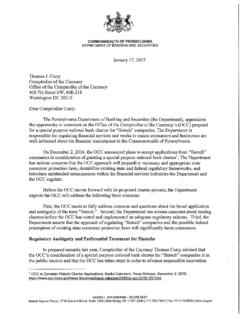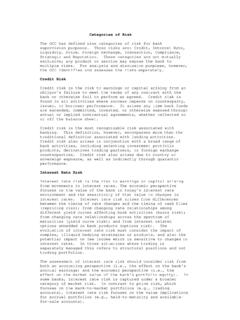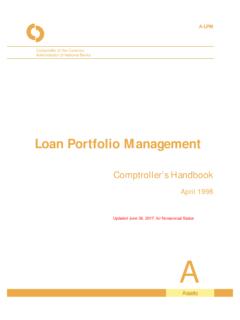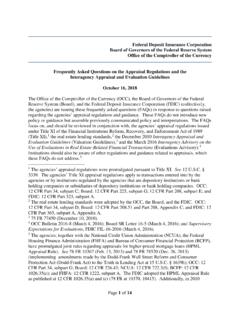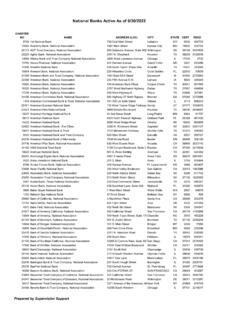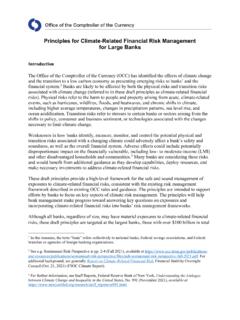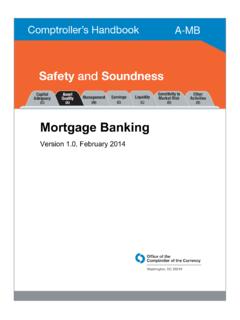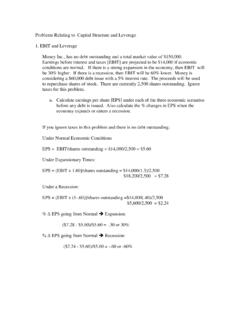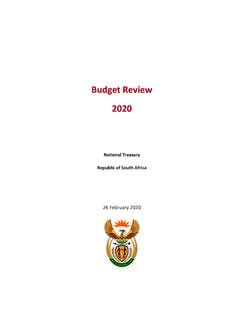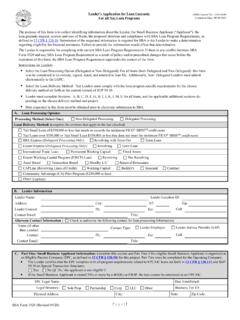Transcription of Leveraged Lending - Office of the Comptroller of the …
1 A-LL. Comptroller of the Currency Administrator of National Banks Leveraged Lending Comptroller 's Handbook February 2008. A. Assets Leveraged Lending Table of Contents 1. Overview .. 1. Leveraged Lending Defined .. 2. Leveraged Lending and the Syndicated Loan Market .. 3. Distributions and Bridge financing .. 4. Risks Associated with Leveraged Lending .. 5. Credit 5. Price Risk .. 8. Liquidity 9. Compliance 10. Reputation Risk .. 10. Strategic Risk .. 11. Risk Management Guidelines and 12. Loan 12. Underwriting Standards .. 12. Policies and Procedures on Loan Acquisition and Distribution.
2 13. Setting Concentration Limits .. 14. Credit Analysis .. 15. Risk Identification System .. 15. Problem Loan Management .. 16. Reports on Leveraged Finance Transactions .. 16. Internal Reviews on Leveraged 17. Allowance for Loan and Lease Losses .. 17. Policies on Purchasing Participations in Leveraged 18. Evaluating the Borrower in a Leveraged Loan Transaction .. 18. Understanding Enterprise 20. Risk-Rating Guidelines for Troubled Leveraged Loans .. 22. Cash Flow/ debt Service Coverage .. 22. Using Enterprise Value .. 24. The Role of Deal 24. Conflicts Of 25. Examination Procedures.
3 27. Expanded Procedures .. 27. Quantity of 31. Quality of Risk 39. Comptroller 's Handbook i Leveraged Lending 46. Appendix A Adverse Risk Rating Examples .. 48. Appendix B Glossary .. 58. Appendix C Accounting for Leveraged Lending .. 68. 72. Leveraged Lending ii Comptroller 's Handbook Leveraged Lending Introduction This booklet describes the fundamentals of Leveraged finance. The booklet summarizes Leveraged Lending risks, discusses how a bank can prudently manage these risks, and incorporates previous OCC guidance on the subject. One of a series of specialized Lending booklets of the Comptroller 's Handbook, Leveraged Lending supplements the general guidance in the Loan Portfolio Management and Commercial Lending booklets.
4 Overview Leveraged Lending is a type of corporate finance used for mergers and acquisitions, business recapitalization and refinancing, equity buyouts, and business or product line build-outs and expansions. It is used to increase shareholder returns and to monetize perceived enterprise value or other intangibles. In this type of transaction, debt is commonly used as an alternative to equity when financing business expansions and acquisitions. It can serve to support business growth and increase returns to investors by financing business operations that generate incremental profits against a fixed equity investment.
5 While it is more prevalent in certain industries and with larger companies, banks provide Leveraged financing to a variety of borrowers for a variety of reasons. Institutions participate in Leveraged Lending activities on a number of levels. In addition to providing senior financing , they extend or arrange credit on a subordinated basis (mezzanine financing ), and can provide short-term, or bridge, financing to expedite the syndication process. Institutions and their affiliates also may take equity positions in Leveraged companies with direct investments through affiliated securities firms, small business investment companies (SBICs), and venture capital companies; or they may take equity interests through warrants and other equity kickers received as part of a financing package.
6 Institutions also may invest in Leveraged loan funds managed by investment banking companies or other third parties. Although Leveraged financing is more prevalent in large banks, it can be found in banks of all sizes. Large banks increasingly follow an originate-to distribute model with respect to large loans. This model, whereby a bank or Comptroller 's Handbook 1 Leveraged Lending group of banks arrange, underwrite, and then market all or some portion of the loan facilities to third-party investors, allows the banks to earn fees while limiting their overall exposure to the borrower.
7 This can be especially important in certain Leveraged Lending transactions, such as those financing corporate buyouts, when the amount of the total credit facility can be quite large. Smaller banks participate in the Leveraged loan market by either purchasing participations in these large corporate loans or by making direct extensions to smaller companies. Leveraged Lending Defined Numerous definitions of Leveraged Lending exist throughout the financial services industry. Depending upon the source, definitions commonly contain one or more of the following conditions: Proceeds used for buyouts, acquisition, and recapitalization.
8 Transaction results in a substantial increase in borrower's leverage ratio. Industry benchmarks include a twofold increase in the borrower's liabilities, resulting in a balance sheet leverage ratio (total liabilities/total assets) higher than 50 percent, or an increase in the balance sheet leverage ratio more than 75 percent. Other benchmarks include increasing the borrower's operating leverage ratios [total debt / EBITDA (earnings before interest, taxes, depreciation, and amortization) or senior debt /EBITDA]. above defined levels such as above EBITDA or EBITDA, respectively.
9 Transactions designated as a highly Leveraged transaction (HLT) by the syndication agent. Borrower rated as a non-investment-grade company with a high debt to net worth ratio. Loan pricing indicates a non-investment-grade company. This generally consists of some spread over LIBOR (London Interbank Offered Rate) that fluctuates as a function of market conditions. Leveraged Lending 2 Comptroller 's Handbook The OCC broadly considers a Leveraged loan to be a transaction where the borrower's post- financing leverage, when measured by debt -to-assets, debt -to equity , cash flow-to-total debt , or other such standards unique to particular industries, significantly exceeds industry norms for leverage.
10 Banks engaging in this type of activity should define Leveraged Lending within their Lending policy. Examiners should expect the bank's definition to clearly describe the purpose and financial characteristics common in these transactions. Leveraged Lending and the Syndicated Loan Market The size and complexity of characteristics inherent in many Leveraged transactions require funding through the syndicated loan market. Loan syndications offer many advantages to borrowers and lenders. Syndicated loans allow borrowers to access a larger pool of capital than any one single lender may be prepared to make available and allow the originating lender the opportunity to provide greater customization than with traditional bilateral relationship-based loans.

